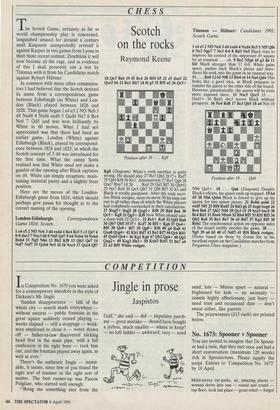CHESS
Scotch on the rocks
Raymond Keene
The Scotch Game, certainly as far as world championship play is concerned, languished unused for around a century until Kasparov unexpectedly revived it against Karpov in two games from Lyons in their most recent contest. Doubtless it will now become all the rage, and as evidence of this I shall presently cite a win by Timman with it from his Candidates match against Robert Hiibner.
In common with many other commenta- tors I had believed that the Scotch derived its name from a correspondence game between Edinburgh (as White) and Lon- don (Black) played between 1826 and 1828. That game began 1 e4 e5 2 Nf3 Nc6 3 d4 Nxd4 4 Nxd4 exd4 5 Qxd4 Ne7 6 Bc4 Nc6 7 Qd5 and was won brilliantly by White in 60 moves. What I had not appreciated was that there had been an earlier game, London (White) against Edinburgh (Black), played by correspond- ence between 1824 and 1825, in which the Scotch concept of 3 d4 was introduced for the first time. What the canny Scots realised was that White need not make a gambit of the opening after Black captures on d4. White can simply recapture, main- taining material parity and a slightly freer position.
Here are the moves of the London- Edinburgh game from 1824, which should perhaps give pause for thought as to the correct naming of the opening.
London-Edinburgh: Correspondence Game 1824; Scotch.
1 e4 e5 2 Nf3 Nc6 3 d4 exd4 4 Bc4 Bc5 5 c3 Qe7 6 0-0 dxc3 7 Nxc3 d6 8 Nd5 Qd7 9 b4 Nxb4 10 Nxb4 Bxb4 11 Ng5 Nh6 12 Bbl Kf8 13 Qb3 Qe7 14 Nx17 Nx17 15 Qxb4 Ne5 16 f4 Nxc4 17 Qxc4 Qf7 18 Qc3 Be6 19 f5 Bc4 20 Rf4 b5 21 e5 dxe5 22 QxeS h6 23 Re 1 Rh7 24 f6 g5 25 Rf5 a5 26 Qc5+
Kg8 (Diagram) White's rook sacrifice is quite wrong. He should play 27 Re7 Qh5 28 f7+ Rxf7 29 Qd4 Kf8 30 Rel. Alternatively 27 Re7 Qg6 28 Qxc7 Rxe7 (if 28 . . Re8 29 Qe5 Bf7 30 Qxb5) 29 fxe7 Re8 30 Qe5 Qh7 31 Qf6 Bf7 32 h3 and Black is totally paralysed. After the rook sacri- fice Black escapes, since on move 30 his king can run to g8 rather than e8 which the White players had completely overlooked in their calculations. 27 Rxg5+ hxg5 28 QxgS+ Kf8 29 Bd4 Be6 30 Qc5+ Kg8 31 Qg5+ Kf8 Now White should take a draw with 32 Qc5+. 32 Bc5+ Ke8 33 Qd5 Ra6 34 Qb7 Qh5 35 f7+ Kxf7 36 Rfl + Kg6 37 Qe4+ Bf5 38 Qe8+ Rf7 39 Qg8+ Kf6 40 g4 Ra8 41 QxaS Qxg4+ 42 Khl Rd7 43 Ba3 Kf7 44 Qc6 Rdl 45 Qxb5 Qe4+ 46 Kgl Kg6 47 Qb2 Qg4+ 48 Qg2 Qxg2+ 49 Kxg2 Bh3+ 50 Kxh3 Rxfl 51 Bel a4 52 a3 Rf5 White resigns.
Position after 26 . . . Kg8
Timman — Wilmer: Candidates 1991; Scotch Game.
1 e4 e5 2 Nf3 Nc6 3 d4 exd4 4 Nxd4 Bc5 5 Nf5 Qf6 6 Nc3 Nge7 7 Ne3 0-0 8 Bd3 Ne5 Black tries to improve his control of the important d5 square by an eventual . . . c6. 9 Be2 N5g6 10 g3 d6 11 h4! Much stronger than 11 0-0. White gains space, pushes back Black's pieces and intro- duces his rook into the game in an unusual way. 11 . . . Re8 12 h5 Nf8 13 Rh4 c6 14 Na4 Qd4 This looks like a good idea, as Black prepares to transfer his queen to the other side of the board. However, paradoxically, the queen will be even more exposed there. 15 Nxc5 QxcS 15 . . . Qxdl + 16 Bxdl dxc5 leaves Black without prospects. 16 Nc4 Rd8 17 Be3 Qb5 18 a4 Not 18
Position after 18 . . . Qa6
Nb6 Qa5 + . 18 . . . Qa6 (Diagram) Despite Black's efforts, his queen ends up trapped. 19 b4 d5 20 Nb6 Qxb6 Black is forced to give up his queen for two minor pieces. 21 Bxb6 axb6 22 exd5 Nf5 23 Rf4 RxdS 24 Bd3 g6 25 hxg6 hxg6 26 Re4 Be6 27 Qd2 Nd4 28 Qc3 c5 29 bxc5 bxc5 30 Bc4 Rh5 31 Bxe6 Nfxe6 32 Rh4 Rf5 33 Kfl Rf3 34 Qb2 Re8 35 Rel Re7 36 a5 Rd7 37 Kg2 Rf5 38 Rehl The synchronised action on opposite sides of the board swiftly decides the game. 38 . . . Ng5 39 a6 b5 40 c3 Ndf3 41 Rf4 Black resigns. (Notes based on those by Zoran Ilic in his excellent report on the Candidates matches from Pergamon Chess magazine.)


















































 Previous page
Previous page